
The EMD FP45 is a cowl unit type of C-C diesel locomotive produced in the United States by General Motors Electro-Motive Division (EMD). It was produced beginning in 1967 at the request of the Atchison, Topeka and Santa Fe Railway, which did not want its prestigious Super Chief/El Capitan and other passenger trains pulled by freight style hood unit locomotives, which have external walkways.
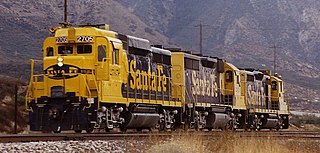
The EMD GP30 is a 2,250 hp (1,680 kW) four-axle diesel-electric locomotive built by General Motors Electro-Motive Division of La Grange, Illinois between July 1961 and November 1963. A total of 948 units were built for railroads in the United States and Canada, including 40 cabless B units for the Union Pacific Railroad.
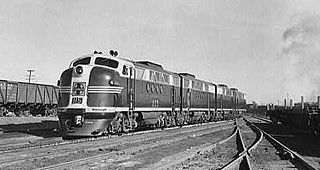
The EMD FT is a 1,350-horsepower (1,010 kW) diesel-electric locomotive that was produced between March 1939 and November 1945, by General Motors' Electro-Motive Corporation (EMC), later known as GM Electro-Motive Division (EMD). The "F" stood for Fourteen Hundred (1400) horsepower and the "T" for Twin, as it came standard in a two-unit set. The design was developed from the TA model built for the C,RI&P in 1937, and was similar in cylinder count, axle count, length, and layout. All told 555 cab-equipped ”A” units were built, along with 541 cabless booster or ”B” units, for a grand total of 1,096 units. The locomotives were all sold to customers in the United States. It was the first model in EMD's very successful F-unit series of cab unit freight diesels and was the locomotive that convinced many U.S. railroads that the diesel-electric freight locomotive was the future. Many rail historians consider the FT one of the most important locomotive models of all time.

EMD F-units are a line of diesel-electric locomotives produced between November 1939 and November 1960 by General Motors Electro-Motive Division and General Motors-Diesel Division. Final assembly for all F-units was at the GM-EMD plant at La Grange, Illinois, and the GMDD plant in London, Ontario. They were sold to railroads throughout the United States, Canada and Mexico, and a few were exported to Saudi Arabia. The term F-unit refers to the model numbers given to each successive type, all of which began with the letter F. The F originally meant "fourteen", as in 1,400 horsepower (1,000 kW), not "freight". Longer EMD E-units for passenger service had twin 900-horsepower (670 kW) diesel engines. The E meant "eighteen" as in 1,800 horsepower (1,300 kW). Similarly, for early model EMD switchers, S meant "six hundred" and N meant "nine hundred horsepower".

The EMD F7 is a model of 1,500-horsepower (1,100 kW) diesel-electric locomotive produced between February 1949 and December 1953 by the Electro-Motive Division of General Motors (EMD) and General Motors Diesel (GMD).

The EMD FP7 is a 1,500 horsepower (1,100 kW), B-B dual-service passenger and freight-hauling diesel locomotive produced between June 1949 and December 1953 by General Motors' Electro-Motive Division and General Motors Diesel. Final assembly was at GM-EMD's La Grange, Illinois plant, excepting locomotives destined for Canada, in which case final assembly was at GMD's plant in London, Ontario. The FP7 was essentially EMD's F7A locomotive extended by four feet to give greater water capacity for the steam generator for heating passenger trains.
Early Electro-Motive Corporation switcher locomotives were built with Winton 201-A engines. A total of 175 were built between February 1935 and January 1939. Two main series of locomotives were built, distinguished by engine size and output: the straight-8, 600 hp (450 kW) 'S' series, and the V12, 900 hp (670 kW) 'N' series. Both were offered with either one-piece cast underframes from General Steel Castings of Granite City, Illinois, denoted by 'C' after the power identifier, and fabricated, welded underframes built by EMC themselves, denoted by 'W'. This gave four model series: SC, SW, NC and NW. Further developments of the 900 hp (670 kW) models gave model numbers NC1, NC2, NW1, and NW1A, all of which were practically indistinguishable externally from the others, as well as a pair of unique NW4 models for the Missouri Pacific Railroad and a solitary, twin-engined T transfer locomotive model built for the Illinois Central Railroad.

The EMD SD40-2 is a 3,000-horsepower (2,200 kW) C-C diesel-electric locomotive built by EMD from 1972 to 1989.
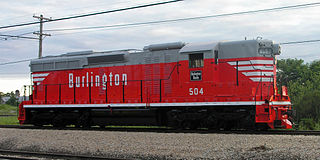
The EMD SD24 was a 2,400 hp (1,800 kW) six-axle (C-C) diesel-electric locomotive built by General Motors' Electro-Motive Division of La Grange, Illinois between July 1958 and March 1963. A total of 224 units were built for customers in the United States, comprising 179 regular, cab-equipped locomotives and 45 cabless B units. The latter were built solely for the Union Pacific Railroad.
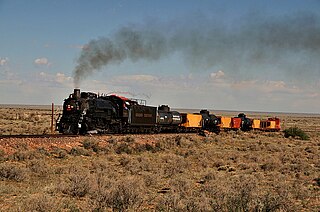
The Grand Canyon Railway is a heritage railroad which carries passengers between Williams, Arizona, and the South Rim of Grand Canyon National Park.

The EMD GP7 is a four-axle (B-B) diesel-electric locomotive built by General Motors Electro-Motive Division and General Motors Diesel between October 1949 and May 1954.

The EMD SD9 is a model of diesel locomotive built by General Motors Electro-Motive Division between January 1954 and June 1959. An EMD 567C 16-cylinder engine generated 1,750 horsepower (1.30 MW). Externally similar to its predecessor, the SD7, the SD9 was built with the improved and much more maintainable 567C engine.

The EMD SD45-2 is a 6-axle diesel-electric locomotive built by General Motors Electro-Motive Division (EMD). EMD built 136 locomotives between 1972 and 1974, primarily for the Atchison, Topeka and Santa Fe Railway (ATSF). The SD45-2 was an improved version of the EMD SD45; the primary visual difference is the lack of flared radiators on the SD45-2.

The EMD GP60 is a model of 4-axle (B-B) diesel-electric locomotive built by General Motors Electro-Motive Division between 1985 and 1994. The GP60 was EMD's first engine that was classified as a "third-generation" locomotive. Hidden behind the electrical cabinet doors on the rear wall of the cab, the GP60 concealed a trio of microprocessors that monitored and managed a host of engine, cooling system and control functions. The engine's on-board microprocessors replaced hundreds of wiring circuits, dozens of relays and all but one module card, making it an improvement among EMD's engines.

The Santa Fe CF7 is an EMD F-unit railroad locomotive that has had its streamlined carbody removed and replaced with a custom-made, "general purpose" body in order to adapt the unit for switching duty. All of the conversions were performed by the Atchison, Topeka & Santa Fe Railway's Cleburne, Texas, workshops between February 1970 and 1978. This was Santa Fe's most notable remanufacturing project, with 233 completed between 1970 - March 1978. The program was initiated in response to a system-wide need for more than 200 additional four-axle diesel road switchers to meet projected motive power demands on branch lines and secondary main lines.

The "Beep" is an individual switcher locomotive built in 1970 by the Atchison, Topeka and Santa Fe Railway at its Cleburne, Texas, workshops. Technically a rebuild, the Beep originally entered service on the Santa Fe as a Baldwin Model VO-1000. Following its successful CF7 capital rebuilding program, the company hoped to determine if remanufacturing its aging, non-EMD end cab switchers by fitting them with new EMD prime movers was an economically viable proposition. The conversion procedure proved too costly and only the one unit was modified. In 2008-2009, this locomotive was retired and stored operational at Topeka, Kansas. In May 2009 the unit was donated to the Western America Railroad Museum in Barstow, California.

The Baldwin VO-1000 is a diesel-electric switcher locomotive built by the Baldwin Locomotive Works between January 1939 and December 1946. These units were powered by a naturally aspirated eight-cylinder diesel engine rated at 1,000 horsepower (746 kW), and rode on a pair of two-axle trucks in a B-B wheel arrangement. These were either the AAR Type-A switcher trucks, or the Batz truck originally developed by the Atchison, Topeka and Santa Fe Railway as a leading truck for steam locomotives. 548 examples of this model were built for American railroads, including examples for the Army and Navy.
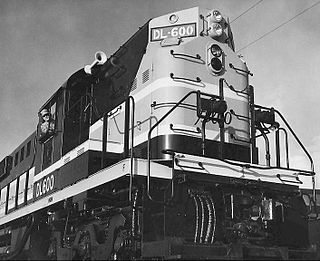
The ALCO RSD-7 was a diesel-electric locomotive of the road switcher type built by ALCO at Schenectady, New York between January 1954 and April 1956. Two versions were built, with the same RSD-7 model designation but different specifications and power ratings, although both used the ALCO 244 engine in V16 configuration. Specification DL-600, of which only two were built, developed 2,250 hp and used the 244G engine. The revised specification DL-600A, numbering 27 locomotives, was rated at 2,400 hp and used the 244H engine. The RSD-7 was superseded by the ALCO 251-engined ALCO RSD-15, which looks very similar. The RSD-7 was the last ALCO diesel built with a 244 engine.

The EMD SD75M and EMD SD75I are a series of similar diesel-electric locomotives produced by General Motors Electro-Motive Division between 1994 and 1996. The series was a response to General Electric's Dash 9-44CW. By increasing the output of the 16-710-G3 engine from 4,000 to 4,300 horsepower, the SD75 was a reality. The "M" in the model designation is the style of the cab, in this case the North American style cab.
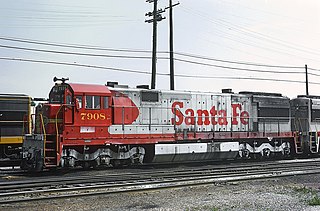
The GE U28CG was a dual-service diesel-electric locomotive produced in 1966 by GE Transportation Systems and derived from their freight-hauling U28C design. The sole customer was the Atchison, Topeka and Santa Fe Railway, which ordered ten early that year for delivery in July and August.



















